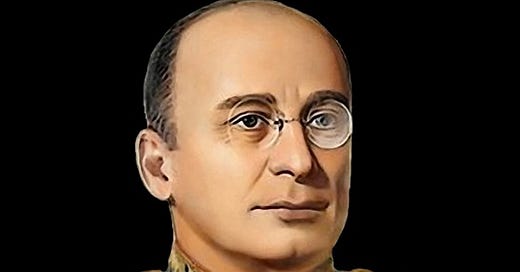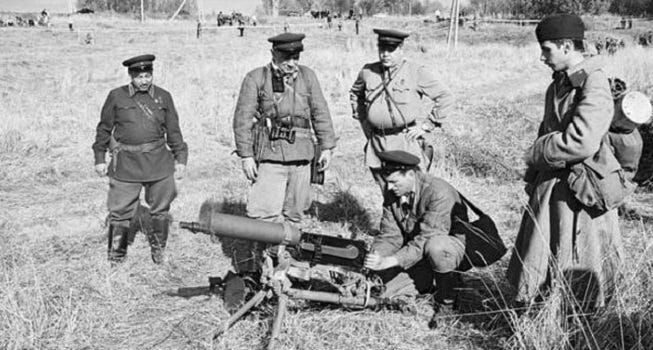The Tradition of Terror Continues
The NKVD's wartime record foreshadowed Russian atrocities in Ukraine
The world was shocked—and surprised—to learn of the war crimes being committed by the Russian armed forces against the people of Ukraine in the course of V. Putin’s war of aggression. But of course, given the frightening and dehumanizing nature of war atrocities are always a possibility. Hatred and enmity magnified by racism on both sides made the war in the Pacific between the US Marines and the Japanese Army a conflict of unspeakable brutality, with no quarter asked or given. On 29 April 1945 at the Dachau concentration camp, American soldiers, horrified by what they found there, lined up and executed by machine gun fire at least a dozen SS camp guards. Shock, fear, anger, horror—throughout history these have been the raw materials of countless battlefield atrocities.
Of a different character, however, are war crimes perpetrated by command, reflecting official policy. Most though not all of the atrocities committed by the German armed forces in World War II, mainly in Eastern Europe, and the USSR, fall into this category. An example is the notorious Commissar Order, promulgated by the High Command of the Armed Forces, stipulating that any Red Army commissar (political officer) taken prisoner was to be summarily executed. And though they’ve received much less attention, there were many officially sanctioned war crimes committed on the Soviet side also, for instance the mass execution of some 22,000 Polish military officers and members of the Polish elite by the NKVD in April-May 1940. But in a characteristic twist, many of the NKVD’s war crimes were perpetrated against the USSR’s own soldiers. A glance back at this dark passage of Russian history seems warranted in the light of current events.
During World War II the People's Commissariat for Internal Affairs—Narodnyy Komissariat Vnutrennikh Del or NKVD—exercised total police power in the USSR. It controlled the ordinary police, the secret political police, the Border Guard, the Gulag (punitive labor camp) organization and the regular prison system. The Internal Troops of the NKVD, nicknamed the Bluecaps, were responsible for the security of public infrastructure such as railroads, industrial installations, power stations, dams, etc., besides maintaining mobile units that could be deployed to break strikes and suppress unrest. In Moscow, the NKVD’s Kremlin Garrison provided security for the nerve center of the Soviet government. All in all, the organs of state security had a marked paramilitary character.
Thus when war broke out on 22 June 1941 the NKVD’s Main Directorate for Mobile Troops mobilized several motorized rifle divisions in addition to its already existing Special Purpose Motorized Rifle Division. These mobile units were intended to supplement the static NKVD guard units and preserve internal order. But in the desperate conditions of the war’s early months many of them had to be committed to combat, fighting as regular soldiers. Additional NKVD rifle divisions were hastily organized, using whatever troops lay to hand, and dispatched to the front. Most of these divisions were eventually transferred to the Red Army.
But the NKVD’s primary military mission was not to fight, but to make sure that others fought. Even before the war, a special motorized NKVD regiment was attached to every field army in the USSR’s five western military districts. These regiments embodied a variable number of “blocking detachments,” usually of battalion strength, whose basic task was to stop unauthorized retreats—if necessary by firing on the retreating soldiers. They were also empowered to detain stragglers and deserters, control traffic, process prisoners of war and maintain order in the Army’s rear areas, serving in effect as the Red Army’s military police corps. At first the blocking detachments were made up of ordinary soldiers under NKVD officers, but sometimes the former proved reluctant to fire on their own comrades, so eventually the job was handled exclusively by NKVD troops. The blocking detachments were armed and equipped as motorized infantry, sometimes including light tank and armored car companies.
A November 1941 report to NKVD chief L.P. Beria detailed the work of the blocking detachments: A precise total of 657,364 Red Army personnel had so far been arrested on suspicion of desertion, and most were immediately sent back to the front. However, 25,878 were detained and variously charged with cowardice, treason, sabotage, espionage, instigating panic among the troops, self-inflicted wounds, etc. More than 10,000 of these men were subjected to the “supreme measure”—summary execution—a third of them publicly, and the rest were consigned to penal battalions. Every field army maintained such battalions and they were committed to battle in the most dangerous situations, with the expectation most of their personnel would be killed.
The NKVD blocking detachments did not always have an easy time of it. On more than a few occasions they had to fight pitched battles with retreating Red Army units that refused to stand fast and be annihilated by the Germans. In this manner Stalin’s ringing slogan—“Not one step back!”—was brutally enforced. Only in 1944, after the war situation had turned decisively in the USSR’s favor, were the blocking detachments scaled back.
Sometime in 1942—the details are murky—the SMERSH organization was created within the NKVD; the name is an acronym based on the Russian for “Death to Spies.” SMERSH was broadly responsible for counter-espionage and counterintelligence and one of its departments dealt with Red Army affairs. Its duties included securing the front line against penetration by enemy agents and “anti-Soviet elements,” investigating treasonous activities in the ranks, preventing desertion and evasion of duty, and processing military and civil personnel freed from enemy captivity. These latter groups were viewed by the regime with the darkest suspicion as potential subversives, and many such people were summarily dispatched to the Gulag. SMERSH was headed by Viktor Abakumov, who became Minister of State Security after the war.
By all accounts SMERSH was highly effective as a counter-espionage and counterintelligence organization. But its supervision of the Red Army was carried out in a manner that reflected Stalin’s own paranoia and cruelty. Among the countless victims of SMERSH was one Captain of Artillery Aleksandr Isayevich Solzhenitsyn, arrested in East Prussia in February 1945 and consigned to the Gulag on grounds of disseminating “anti-Soviet propaganda.” This consisted of critical comments in a private letter to a friend about the horrific atrocities committed by Red Army troops against German civilians. (Solzhenitsyn was later to take a grand literary revenge on his oppressors.)
It is certainly true that patriotism reinforced by a deep hatred of the Nazi enemy motivated Soviet soldiers. But these primitive emotions were buttressed by a systematic reign of compulsion and terror perpetrated by the organs of state security. As Stalin himself once remarked to Winston Churchill, it took a brave man to be a coward in the Red Army. Russian ideas about military discipline seem not to have changed very much since then.
The NKVD also played a key role in the “liberation” of eastern Europe; that is, in the imposition of communist regimes on such countries as Poland, Rumania and Hungary. The method of the purge, already well tried in the USSR itself, was applied to the new provinces of the Soviet empire. “Anti-Soviet elements” were hunted down, arrested and either liquidated on the spot or consigned to the Gulag. The similarity to what is going on in Russian-occupied areas of Ukraine could not be more obvious: mass shootings and deportations aimed at breaking resistance, eliminating potential opposition leaders, and reducing the remaining population to a state of numb docility.
In peace and war, the NKVD’s conduct reflected the character of the Stalinist Soviet Union—indeed of the dictator himself. The same may be said of the conduct of the Russian armed forces in Ukraine today—it’s an accurate reflection of Putinist Russia and of V. Putin himself. That’s worth remembering as Russia celebrates Victory Day to the accompaniment of presidential rants about Ukrainian “Nazis.”
Author’s Note, 12 May 2022: Many thanks to The Cosmopolitan Globalist magazine and to Claire Berlinski in particular for republishing this essay.





This is superb. I wonder if you might give us permission to republish it in the magazine?